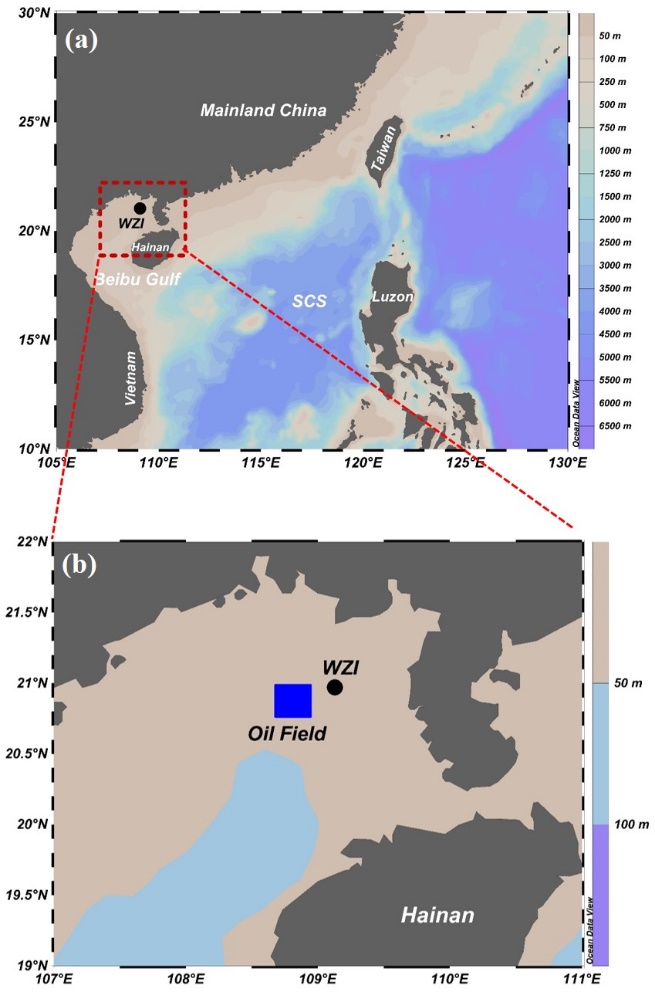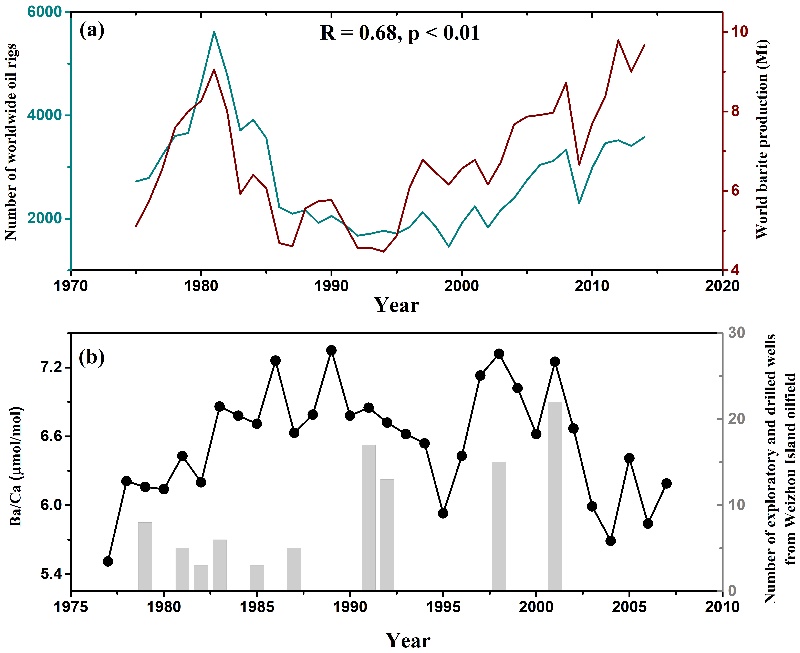Offshore oil exploitation has a disastrous impact on marine ecological environment, resulting in the death or extinction of marine benthic animals. However, full understanding of these effects is hindered by sparse observations in many areas of the world.
Weizhou Island oil group is the largest oilfield in the South China Sea. Dr. LI Xiaohua of Prof. SUN Weidong's team at the Institute of Oceanology, Chinese Academy of Sciences (IOCAS), generated annually and seasonally resolved records of Ba/Ca ratios in the Porites coral sample collected from Weizhou Island to study the oil exploration and drilling activities around Weizhou Island.
The study was published in Marine Pollution Bulletin.
During the years 1983-1994 and 1996-2002, coral Ba/Ca ratios increased by 12%-17%. Terrestrial input seems to have small effects on coral Ba/Ca, since precipitation shows no evidence of an increase in coupled with the increase of coral Ba/Ca records.
The variability in coral Ba/Ca values coincided with oil exploration and drilling activities around Weizhou Island. Barite is the main component of waste from offshore drilling platforms and is used as a weighting agent during oil exploration and drilling operations. Following drilling activities, Ba concentrations in seawater have been shown to increase markedly, which can be recorded in coral Ba/Ca.
On seasonal timescales, Ba/Ca maxima occur in the dry season, which differs from the typical coral seasonal peaks in the wet season. Weizhou Island is situated in the East Asian monsoon area, which has a higher wind speed during winter (6-7 m/s) than summer (3-4.5 m/s). Re-suspended sediment on the shelf triggered by the winter monsoon is therefore identified as an important source of coral Ba/Ca peaks.
This study provides a long-term and continuous on-site record for oil exploration and drilling activities that can be used for offshore oil management. "Furthermore, our approach offers a way to study the influence of oil-related activities on the marine environment when no oil exploration and drilling records are available," said Prof. SUN.
This study was supported by National Science Foundation of China, the Strategic Priority Research Program (B) of the Chinese Academy of Sciences.

Fig. 1 Bathymetric map of the South China Sea (SCS) showing the locations of (a) Beibu Gulf and (b) Weizhou Island. The black circle indicates the sample site for the coral WZI used in this study. The blue square indicates the location of the oil field in the Beibu Gulf.

Fig. 2 Comparisons between (a) the number of oil rigs worldwide (cyan line) per year and world barite (BaSO4) production (purple line) since 1975; (b) annual coral Ba/Ca ratios (black solid circle) from coral WZI and the number of wells drilled (gray column) from the Weizhou Island oilfield.

Fig. 3 Time series of Ba/Ca ratios (black solid circle) from the coral WZI versus wind speed (olive solid circle): (a) annually resolved records over the interval 1977-2007 (annual values of wind speed were calculated by averaging the monthly wind speed); (b) bimonthly records over the intervals 1996-1999 and 2002-2006. The gray shading area are the periods of Ba/Ca peaks.
Li, X. H., Zhang, L. P., Liu, Y., Sun, W. D. (2022). The Ba/Ca record of coral from Weizhou Island: Contributions from oil-drilling muds and the winter monsoon. Marine Pollution Bulletin, 174, 113317.
LI Xiaohua
Institute of Oceanology
E-mail: lixh@qdio.ac.cn
(Editor: ZHANG Yiyi)
|
|

Address: 7 Nanhai Road, Qingdao, Shandong 266071, China
Tel: 86-532-82898902 Fax: 86-532-82898612 E-mail: iocas@qdio.ac.cn


